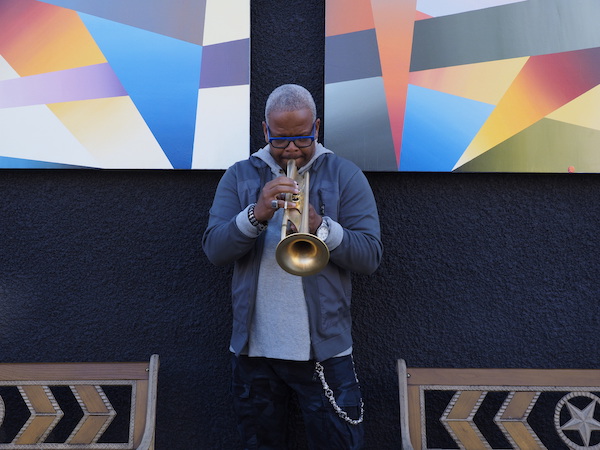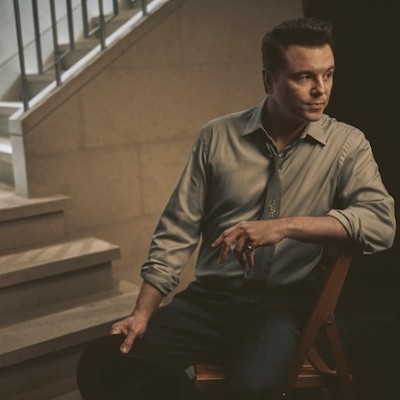Dec 9, 2025 12:28 PM
In Memoriam: Gordon Goodwin, 1954–2025
Gordon Goodwin, an award-winning saxophonist, pianist, bandleader, composer and arranger, died Dec. 8 in Los Angeles.…

Terence Blanchard—who won a Grammy in the category Best Instrumental Composition for “Blut Und Boden (Blood And Soil),” a work featured in Spike Lee’s 2018 movie BlacKkKlansman—composed the score for the filmmaker’s latest effort, Da 5 Bloods.
(Photo: Henry Abenejo)I heard you tell a story about a guy who came up to you after a show and said you’d changed his mind about gun control. Are there other versions of that?
Unfortunately, that was a unique situation. Probably because most people who come to my shows are of like minds, I guess. I’m not sure.
I’ve had the exact opposite happen to me at one show, where a guy came up to the band outside and only wanted to talk to the guitarist, who was white. When Charles [Altura] went to talk to him, he said, “You can keep your liberal bullshit.”
That makes no sense for nine different reasons.
Yeah, the thing that was weird about that was, he must not have known who I was and come to my show [laughs]. You obviously don’t know what this music is about—and what we’re about.
Luckily, that’s not the norm. Generally, people have been coming up to us and thanking us for what we’ve been doing. I remember, in Staten Island, Eric Garner’s family came, and we did the music to Breathless. We were all in tears afterward. To be around a family who lost a loved one in such a senseless manner, it was a powerful moment.
Has the coronavirus affected the planning of your opera, Fire Shut Up In My Bones? It seems like the new Perry Mason TV series, which you’re doing the music for, already was pretty deep into production by the time the pandemic hit.
With Perry Mason, we had to do remote recording with the musicians; it turned out pretty well. Other than that—and social distancing—still staying on schedule and approving things. That part hasn’t changed.
Actually, I feel really blessed to be one of the few people who’s working right now; it’s a trying time for a lot of people. It’s a frustrating thing to witness: You feel like you’re left out here all alone, because we don’t have a plan to deal with this as a country. It should be a wake-up call. There’s got to be reckoning for what’s going on—in some form or fashion.
It’s all interrelated. And that’s what part of your piece for NPR was about. You cited a study that said something like 3.5 percent of the country needs to participate in a social movement for it to actually force some sort of change. I don’t know if we’ve gotten there yet.
I do think there are a lot of people who are waking up to what’s going on. Let’s see how this plays out. I’ve gotten my hopes up before, only to have my heart broken. When Eric Garner was murdered, I thought for sure something was going to happen. When Philando Castile was murdered, I was sure. When the little kid, Tamir Rice, was shot, I thought something was going to happen.
We’re on the edge of two very different worlds. In the NPR piece, you said that “protest is patriotic.” There are people in the streets saying that the killing of Black people by law enforcement needs to stop. And then there’s this other faction who showed up to the Michigan state house with semi-automatic rifles, because they wanted businesses to open.
That shows you that there’s still a huge issue in terms of education in this country that we need to deal with. [Republicans] are adept at getting a certain group of people to vote against their own interests. And some of the people who are angry and support the president, some of their gripes are extremely valid. It’s how they’re couched in nonreality that doesn’t allow them to get the result they desire.
This goes back to the Southern strategy, when they started to really play to that fear. They always had to have a boogeyman to blame. Now, I feel like this is the reckoning, because of that deal. It’s sad, because it results in people being out in the streets with idiotic signs that don’t make any sense. You can go point by point and look at what [the president] has promised them, and it still hasn’t happened.
I think this racism is a fallout from that.
Here’s the thing I’ve been saying that nobody wants to deal with. Jane Elliott’s blue eye/brown eye test should be a part of every grammar school curriculum across the country. … If anybody truly wanted to tackle racism in this country, that would be a part of the education system. Why isn’t it?
[Elliott] gave a lecture at a college that had a bunch of white kids there—presumably they were all liberal white kids; I’m not sure. And she asked all of them, “Who here would trade places with a Black person in America? Raise your hands.”
Nobody raised their hands. Then she said, “The mere fact that you didn’t raise your hands lets me know that you understand what’s going on.” She said: “Your silence is complicity.”
Think about all these Confederate statues and the constant bombardment of watching Cops, when it’s always a Black guy being arrested. People buy into it on both sides of the issue. That’s the conditioning that we really have to deal with.
When they took down the P. G. T. Beauregard statue here, which is not too far from my house—I grew up driving by that thing, going to school every damn day. I never would have thought about it. But when they took the statue away, it was like somebody took a weight off of my shoulders that I didn’t even know was there.
In your NPR piece, you said that you’re cautious about what happens next. But how do you push yourself to keep making work that moves the needle in the right direction?
You keep creating art that hopefully engages people in a conversation about it. That’s the least I can do—other than being in the streets protesting. I’m cautiously optimistic, because the track record of this country hasn’t been a great one. We love to get involved and then fall back into complacency and move on to the next thing.
What’s different about this is that I think the universe has stopped the world for us to sit down and deal with this stuff. I don’t think it’s an accident that this is happening during the COVID-19 period, when you have these young people who can’t go to class or a job—or anything. But they can stay out there and protest. That, combined with the way that George Floyd was killed, has sparked a movement that I haven’t seen since I’ve been on this planet.
I just hope we can maintain this level of energy and frustration and anger. And be levelheaded enough to strategize legislation. Come on, man, you can’t outlaw lynching and you can’t outlaw choke holds? That’s shameful. Right there, it’s a start.
The other part is that you have to hold these guys accountable. It looks like that’s going to happen. But then we have to get back to training, and think about that next generation—the people coming up. We’ve got to put Jane Elliott’s program in elementary schools to actually deal with this, so kids can get an idea of what other people are going through. DB

Goodwin was one of the most acclaimed, successful and influential jazz musicians of his generation.
Dec 9, 2025 12:28 PM
Gordon Goodwin, an award-winning saxophonist, pianist, bandleader, composer and arranger, died Dec. 8 in Los Angeles.…

Flea has returned to his first instrument — the trumpet — and assembled a dream band of jazz musicians to record a new album.
Dec 2, 2025 2:01 AM
After a nearly five-decade career as one of his generation’s defining rock bassists, Flea has returned to his first…

“It’s a pleasure and an honor to interpret the music of Oscar Peterson in his native city,” said Jim Doxas in regard to celebrating the Canadian legend. “He traveled the world, but never forgot Montreal.”
Nov 18, 2025 12:16 PM
In the pantheon of jazz luminaries, few shine as brightly, or swing as hard, as Oscar Peterson. A century ago, a…

Dec 11, 2025 11:00 AM
DownBeat presents a complete list of the 4-, 4½- and 5-star albums from 2025 in one convenient package. It’s a great…

Seth MacFarlane takes a turn from his television and film career to sing arrangements made for Frank Sinatra, but never recorded.
Nov 18, 2025 12:04 PM
“I’m not gonna lie to you — I don’t know why I thought this was about The Naked Gun, but I’m happy it’s…